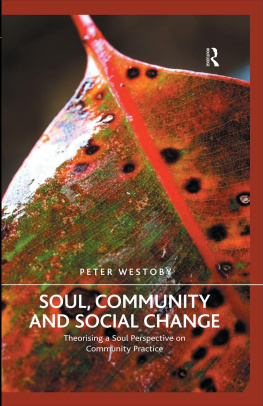Bibliographic information published by the Deutsche Nationalbibliothek
The Deutsche Nationalbibliothek lists this publication in the
Deutsche Nationalbibliografie; detailed bibliographic data
is available on the Internet at http://dnb.d-nb.de.
2010 E-Book-Ausgabe (EPUB) 2nd revised edition 2008
Verlag Bertelsmann Stiftung, Gtersloh
Responsible: Peter Walkenhorst
Editor: Peter Walkenhorst
Production editor: Sabine Reimann
Cover design: Nadine Humann
Cover photo: Veit Mette, Bielefeld
Typesetting and print: Hans Kock Buch- und Offsetdruck GmbH, Bielefeld
ISBN : 978-3-86793-233-2
www.bertelsmann-stiftung.org/publications
www.bertelsmann-stiftung.de/verlag
Inhaltsverzeichnis
Introduction
During the last two decades the community foundation concept has spread around the globe. Community foundations currently constitute one of the fastest growing forms of organized philanthropy. More and more cities, regions and metropolitan areas worldwide are adopting the idea of a community foundation to promote sustained, community-based philanthropy and to address changing local needs. It is quite likely that this trend will continue in the future.
The widespread shift from longstanding social welfare policies to new forms of public-private partnership is encouraging the globalization of the community foundation concept. Increasingly, the responsibility of national and local governments for the funding and delivery of social services has devolved either to private, for-profit institutions or not-for-profit, civil-society-oriented organizations that operate outside the traditional public and private sectors. These developments, as well as the communications revolution of the past two decades, have prompted a tremendous increase in the number and growth of civil society organizations all over the world-a phenomenon that has been described as a global associational revolution.1 Community foundations are part of this global associational revolution, and they are at the core of the search for a new balance between the state and civil society. They are strategically positioned to strengthen community capacity by fostering local philanthropy and civic engagement.
The worldwide spread of community foundations also derives from the adaptability of their core ideals across national and cultural borders. Although first invented in the United States, the community foundation concept is no longer solely an American idea.2
The idea of a foundation that focuses on local and regional needs and builds a permanent endowment through contributions from a wide range of donors has proven its ability to adjust to various cultural, societal and legal environments. This flexibility and ability to reinvent itself is probably the greatest strength of the community foundation model. Consequently, as the concept continues to proliferate around the world, it will introduce further modifications in response to different societal contexts and cultural traditions.3
In recognition of these global trends, the Bertelsmann Foundation and the Charles Stewart Mott Foundation have formed a strategic alliance to promote and facilitate the development of community foundations in Germany and Europe. Bertelsmann, with support and advice from Mott, has created the Transatlantic Community Foundation Network (TCFN), to support the exchange of experience and expertise among community foundations and support organizations from Europe, North America, and Mexico and to foster the development of this form of philanthropy in countries where the concept is new.4
This book is a product of the growing collaboration. It intends to provide all those interested in the community foundation model with comprehensive information about this form of philanthropy as well as with concrete guidelines to facilitate the development of this kind of foundation. With the exception of the article by Eleanor W. Sacks, all contributions to this book were first published in 2001 and are reprinted here in their original versions. While the authors have revised data and figures as well as outdated web links and bibliographical information to the degree possible, their articles appear essentially as they were originally published. Only the article by Eleanor W. Sacks has been completely rewritten and updated in order to catch up with the rapid spread of the community foundations concept around the world.
All authors assume the growing importance of community foundations as well as the fact that the current expansion of global capital markets and the intergenerational transfer of wealth offer great promise for the future growth of these unique institutions. Their increasing importance further implies that issues of strategic focus, key competencies and organizational effectiveness will also become more important. However, greater effectiveness will depend in turn upon the foundations strengthened capacities. The information in this book aims to contribute to the strengthening of their management capabilities and thereby their ability to fulfill their core mission: building stronger communities through strategic philanthropy.
In this context, the article by Eleanor W. Sacks focuses on the history, development and characteristics of community foundations from an international perspective. As a general introduction to the topic, it provides an overview of the growth of community foundations around the world and analyzes the driving forces that have contributed to this development.
One important aspect of the work of community foundation is that they not only build philanthropic but also social capital- a concept that has received increasing attention in recent years from social scientists and policymakers alike. Social capital, understood as the social networks and the norms of reciprocity and trustworthiness that arise from them, is a vital resource of modern, pluralistic societies.5 Like other natural resources, it is not available in unlimited quantities and therefore needs to be used in a responsible and sustainable way. As Lewis M. Feldstein and Thomas H. Sander point out, by pursuing a variety of different strategies, community foundations can make significant contributions to the preservation and creation of social capital in their communities.
Notwithstanding the importance of building social capital, one of the most important objectives of a community foundation remains the long-term building of a permanent collection of endowed and other funds contributed by a wide range of donors. Helen Monroe identifies key elements of successful asset development, and Shannon E. St. John describes the focus upon services to those donors that has been perhaps the major reason for the extraordinary growth of U.S. and Canadian community foundations in recent decades. Both articles offer practical guidelines and good practice recommendations that may assist other community foundations as they seek to build their endowment, raise other funds and serve donors.
The ultimate success of a community foundation rests to a high degree upon the public acceptance of its activities. Effective community foundation work therefore relies on effective communications. As Mary Command and Donnell S. Mersereau show in their article, marketing has become an important part of community foundation communications. The authors share a five-step process for developing a marketing plan.











